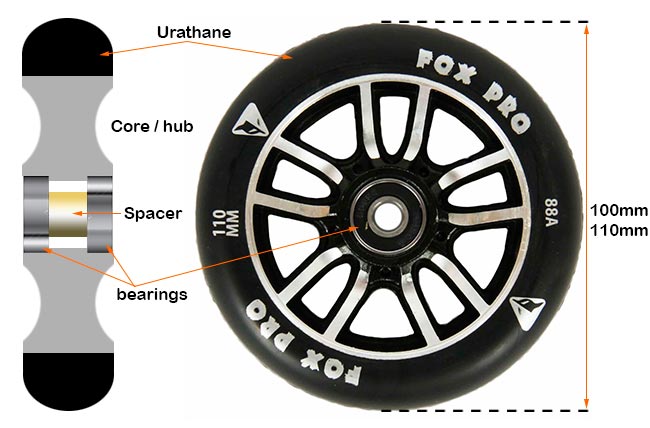Stunt scooter wheels
Scooter wheels/Introduction
See wheels
Most wheels on stunt scooters have a diameter of 100 mm or 110 mm. However, some wheels can have a diameter of up to 125 mm.
The diameter of a wheel determines the properties of a wheel in terms of its ability to ride over uneven surfaces. Large wheels are good for transportation, because it is fast and will roll over anything. A large wheel provides a higher rotation speed, which means it can achieve higher speed.
Smaller wheels are good, because they fit most scooter setups. It is lighter which makes the scooter more agile.
Urethan is the term used for the tire itself within the skateboarding community. It is a material which all skateboarding tires are made from. How hard a wheel is, is measured on the durometer scale (often referred to a duro). You should choose a hard wheel, if you spend a lot of time riding ramps or well-paved roads as it gives less resistance. A soft wheel is preferred when riding on uneven asphalt or riding for a long time.
Soft wheels will, however, get worn faster.
Scooter wheels/bearings
See ball bearings
The bearings are what make the wheels run freely and without friction. Bearings consist of 6-8 little balls which are secured between the inner and outer race. The little balls are secured in the same distance between them with a retainer. The bearings are protected by shields, so dirt cannot ruin it.
You need 2 bearings per wheel which are fastened together with a spacer in the middle of the wheel.
Bearings are categorized by the ABEC (Annual Bearing Evaluation Committee) system. Bearings are usually assessed on a scale for 3 to 9. High values mean that the bearings are made with high precision (high value = tight tolerance = more expensive bearing). However, this does not mean that bearings with no rating are bad!
Scooter wheels/spacers
A spacer is often overlooked. If you are not using the right spacer, the durability of your bearings will be decreased and will never run the right way- not even from the beginning.
Most wheels will work well with a 10-mm spacer. Some manufacturers will, however, recommend a certain width of the spacer. Regardless of your choice, you must never ride without a spacer.
Scooter wheels/spacer too wide
If the spacer is too wide and you press the bearing into the wheel, you might find that you will press the outer race inward while the inner race is pressed outward due to the spacer. This causes unnecessary friction and will make your wheel slower and reduce the durability of the bearings.
The symptoms of a false spacer are: slow rotating wheels and ruined bearings.
Scooter wheels/spacer too narrow
If you do not have a spacer or just one spacer that is too narrow, you might find that you will press the inner race inward while the outer race stays in place. This causes friction and will cause your wheel to run slower and reduce the durability of the bearings.
The symptoms of a false spacer are: slow rotating wheels, ruined bearings, a need to re-tighten the shafts again and again.




